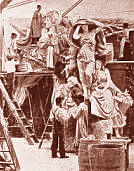

![]()
![]()
This Page:
Sarah Fisher Ames
Caroline Peddle Ball
Sarah Bernhardt
Amy Aldis Bradley
Hélène Bertaux
Carrie L. Brooks
Caroline S. Brooks
Marie Cazin
Camille Claudel
Katherine M. Cohen
Ellen Rankin Copp
![]()
![]()
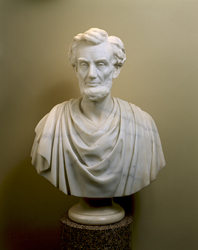
Bust of Abraham Lincoln 1868--exhibited in
the Woman's Building, 1893 Exposition.
Bust of Ulysses S. Grant (image unavailable)--
exhibited in the Woman's Building, 1893 Exposition.
Sarah Fisher Clampitt Ames was born in Deleware and educated in Boston. She spent a short period of time in Rome, where she was classified sometimes with the "white, marmorean flock" or the "strange sisterhood," as Henry James somewhat sneeringly called the colony of expatriate American women sculptors living there--but it is not clear that she actually studied sculpture while there. She married painter Joseph Ames, with whom she had an "open marriage" that must have kept proper Boston society on its toes, but she had a successful career as a sculptor, famous especially for five different busts of Abraham Lincoln. One of those busts was exhibited in the U.S. Senate gallery for a time, but is now in the Massachusetts State Capitol. Her acquaintance with the president probably dated back to her time as a nurse in Washington, D.C. during the Civil War; she was personally acquainted with a number of the famous abolitionists at that time.
![]()
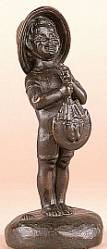
Trophy--representative work.
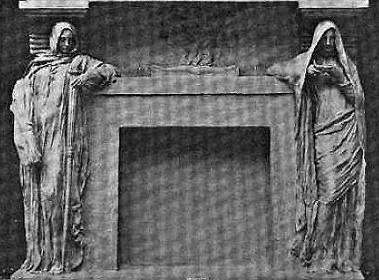
A Mantlepiece--representative work.
Queen Isabella Coin--souvenir item designed as a
money-maker for the Woman's Building. See image here.
Head of the Virgin or The Young Virgin
(image unavailable)--included as part of the
Tiffany Glass Company exhibit, 1893 Exposition.
Caroline Peddle Ball was born in Terre Haute, Indiana to Charles Rugan Peddle, a railroad official, and Mary Elizabeth Ball Peddle. She studied art privately at the Rose Polytechnic Institute, followed by a brief sojourn at the Pennsylvania Academy of Fine Arts, and then in New York at the Art Students’ League under Kenyon Cox and Augustus Saint-Gaudens. For a time, she was employed by Tiffany Glass and Decorating Company which exhibited her design at the 1893 Chicago Exposition. She was also commissioned to design the "Isabella" 25-cent souvenir coin, but "creative differences" caused her to withdraw from that honor. During the 1890s she lived and worked in Florence, Italy and Paris, France, as well as in Terre Haute. She was married for a time to Bertrand E. Ball.
![]()

Bernhardt
in her studio
at avenue de Villiers with
self-portrait bust [photo]
1878--representative work.
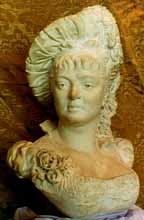
A Portrait Bust of an Actress
c.1885-1895--
representative work.
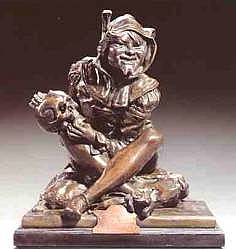
Le Bouffon (a jester)--
representative work.
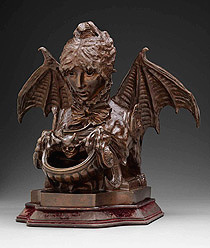
Fantastic Inkwell (Self-
Portrait as a Sphinx) 1880
--representative work.
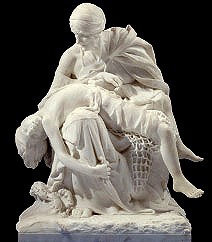
After the Storm
1876--representative work.

Ophelia
--exhibited
in the Rotunda, Woman's
Building, 1893 Exposition.

Louise
Abbema--exhibited
in the Rotunda, Woman's
Building, 1893 Exposition.
Bust of child (image unavailable) --exhibited in
the Rotundra,
Woman's Building, 1893 Exposition.
One of the most famous actresses of the nineteenth century, Sarah Bernhardt (born Henriette-Rosine Bernard) was
born in Paris of French-Dutch-Jewish heritage (her father unknown). Known for her role as Camille in La Dame aux Camélias by the younger Alexandre Dumas,
she was also famous for donning "breeches" and playing males roles like Hamlet. Oscar Wilde named her "The Divine Sarah" and wrote his play
Salome for her. Bernhardt was also an accomplished (and largely self-taught) sculptor who studied for a time with Mathieu-Meusnier, an academic
sculptor of public monuments and sentimental pieces, and she exhibited her work (more than 50 documented statues) regularly in Paris, London, Chicago, and New
York from the 1870s to about 1900. In her sculpture studio in Montmartre, she often entertained her guests in the "sculptor's outfit" shown above--a white satin blouse
and white silk trousers. Always outré, she enoucouraged the rumor that she slept in a coffin. Her autobiography, Memories of My Life, was published in 1907.
For more on Bernhardt as the "subject" of art, see the
Louise Abbéma entry.
Sculptured Self-portraits--4 images
![]()
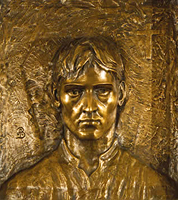
Father Jacques Marquette
(bronze relief of Jesuit Priest and explorer) 1895--
located in famous Marquette Building, Chicago.
Daughter of the Pharaohs and Bust of a Boy
(images unavailable)--exhibited in
the Fine Arts Palace, 1893 Exposition.
Amy Aldis Bradley, whose ancestors were Massachusetts emigrants in the 1630s, was born in Vermont to prominent attorney Asa Aldis and his wife Mary. Amy studied sculpture in Paris from 1888 to 1890, and was married to Richards Bradley in 1892. They had five daughters.
![]()
(NOTE: The records for the 1893 Exhibition badly misspell her name as "Bortanae" and "Bertaut.")
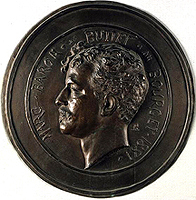
Le Baron Marc de Buttet du Bourget
--representative work.
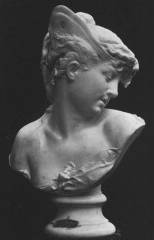
Spring--
representative work
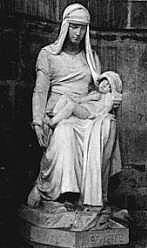
Flight
into Egypt--
representative work.
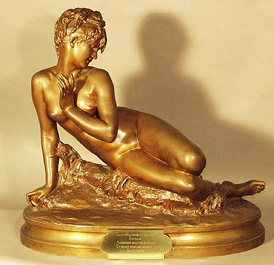
Eveillee [Resting Young Nude Girl with a Dragon Fly on
her Back] c. 1870--exhibited as
Young Girl Bathing
in the Rotunda, Woman's Building, 1893 Exposition.

Psyche under the
Influence of the
Mystery 1889--
exhibited in the
Rotunda, Woman's
Building, 1893 Exhibition.
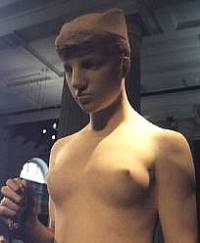
Psyche under the
Influence of the Mystery
--
close-up of statue on the left.
Bust of Sophia Arnould (image unavailable)--exhibited
in the Rotunda,
Woman's Building, 1893 Exposition.
Hélène (Pilate) Bertaux was born in Paris and received her first training from her mother's companion (sculptor Pierre Hébert), followed by later studies with Augustin Dumont. She frequently exhibited, her earliest ones being in her first married name "Allélit," but after 1857, in the name of her second husband: "Madame Leon Bertaux." She also played a major role in getting women's artistic endeavors recognized by organizing the Union of Women Painters, Sculptors and Engravers in 1881, functioning as the editor of its monthly journal, establishing the first sculpture school for women, and setting up several monetary awards for women artists. She also worked to force the Ecole des Beaux-Arts to admit women and, in 1896, became the first woman member elected to the Ecole des Beaux-Arts.
![]()
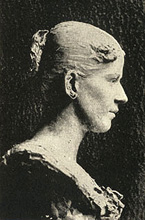
Portrait Bust of Mrs. Dutton--
exhibited in Illinois Building, 1893 Exposition.
Enid [bust of child] (image unavailable)--
exhibited in the Fine Arts Palace, 1893 Exposition.
Carrie L. Brooks was born in Illinois and was trained at the Art Institute of Chicago. No other information is available online.
![]()

Caroline S. Brooks demonstrating her
butter-molding techniques with a
bas-relief of Columbus
for the 1893 Exposition.
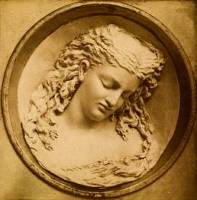
The Dreaming Iolanthe 1876
--based on her famous "butter
sculpture" on the same theme
exhibited at the 1876 Centennial
Exposition in Philadelphia, but
a marble version was exhibited
in the Fine Arts Palace,
1893 Exposition.
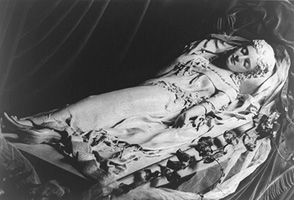
Sleeping [or Awakening] Iolanthe
1878--full-length marble version
of her "butter sculpture," created
for the 1878 Paris Exposition.

Lady Godiva--exhibited
in the Fine Arts
Palace, 1893 Exposition.
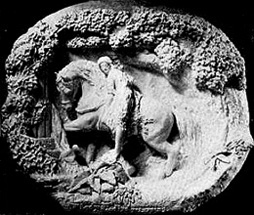
Lady
Godiva Returning--exhibited
in the Fine Arts Palace,
1893 Exposition.
'La Rosa' [Vanderbilt family grouping] (image unavailable)--
exhibited in the Fine Arts Palace, 1893 Exposition.
George Eliot (image unavailable)--exhibited in the
Cincinnati Room,
Woman's Building, 1893 Exposition.
Born in Cincinnati, Ohio, Caroline S. Brooks is sometimes described as a self-taught sculptor, but other sources say she graduated from St. Louis normal school and was a student at the Art Institute of Chicago under Lorado Taft and perhaps studied also in Paris and Florence. She created sculpted marble portraits of a number of important public figures, including three USA presidents and their wives. Although her exhibits at the 1893 Exposition were all in marble, she was more popularly known, or mocked, as the case may be, as the "butter lady" as she demonstrated in the Florida Building her method of molding in butter to make portraits of Columbus, Queen Isabella, and other figures like Amerigo Vespucci. Unfortunately, her Lady Godiva statues exhibited at the Colombian World's Fair in 1893 were later destroyed in the 1906 earthquake. She was married to Samuel H. Brookes, an Arkansas farmer, county treasurer, and later state legislator.
![]()
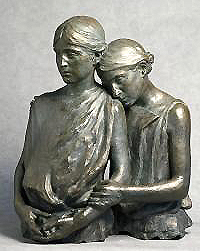
Jeune Filles (Young Girls)--exhibited in the
Fine Arts Palace, 1893 Exposition.
Marie Cazin was born in Paimboeuf, France and received some early training from Juliette Peyrol-Bonheur and later with her husband Jean-Charles Cazin, a painter and ceramicist. Although she did some early work with decorated ceramics and was known for her paintings (see French Women Painters: Cazin), she annually exhibited her sculpture at the Salon for thirty years.
![]()
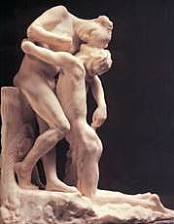
Cacountala--
representative work.

Clotho--
representative work.
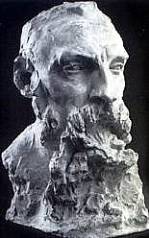
Bust of M. Rodin--representative work.
Born at Fère-en-Tardenois, Aisne, Camille Claudel studied at the Académie Colarossi in Paris under the sculptor Alfred Boucher (women were not allowed to enroll in the École des Beaux-Arts) and later under the famous sculptor Auguste Rodin. For fifteen difficult years, Camille was Rodin's muse, model, confidante, and lover. The commercial success she attained in her post-Rodin period ended in the early twentieth century with signs of her deteriorating mental condition which caused her to destroy many of her works. She lived out her final years in a mental asylum.
![]()

The Isralite--
representative work.
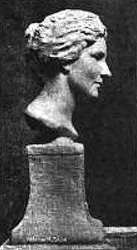
Romola--
representative work.
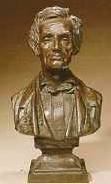
Bust of Abraham
Lincoln (1898)--exhibited in the
Fine Arts Palace, 1893 Exposition.
Bust of Henry Souther (image unavailable)--
exhibited in Fine Arts Palace, 1893 Exposition.
Katherine M. Cohen was born in Philadelphia to immigrant parents from England. She studied art at the Pennsylvania Academy of Fine Arts under painter Thomas Eakins and worked at the Art Students League in New York City as an assistant to the famous sculptor Augustus Saint-Gaudens. Later, she studied in Paris under sculptors Puech and Mercie. At the 1893 World's Fair, she delivered a speech on "The Life of Artists" at the Women's Pavilion and her sister Mary addressed the Jewish Women’s Congress. Katherine often created portrait busts of prominent Philadelphia Jews or employed Jewish themes in her work.
![]()

Judge John Rankin--exhibited in the
Ohio State Building, 1893 Exposition.

Maternity--statue for the
Illinois State Building,
1893 Exposition.
(Sculptor
on the right.) See also
statues.
Pele, Goddess of Fire--commissioned statue at entrance
of the Volcano Cyclorama on the Midway Plaisance.
See images here.
Relief Portrait of Mrs. Palmer Potter--displayed
in Library, Woman's Room, 1893 Exposition.
See bronze image of Mrs. Palmer here.
Little David Wegg and Mother Eagan (images unavailable)--
exhibited in the Illinois State Building, 1893 Exposition.
Relief bust of Miss Harriet Monroe (image unavailable)--
exhibited in Fine Arts Palace, 1893 Exposition.
The ancestors of Ellen Rankin Copp came to America during the 17th Century to escape religious persecution; she also had family members who fought in the Revolutionary War, the War of 1812, and the Civil War in which her father served as a surgeon on the Union side. Her grandfather became famous as the abolitionist, Judge Rankin, who advised Harriet Beecher Stowe on the underground railroad for escaped slaves. A self-taught painter from a small town in Illinois, Rankin-Copp married William H. Copp and, at age 36, enrolled in the Art Institute of Chicago to study sculpture. She became the first woman in Chicago to be a sculptor, and continued her studies for another year in Munich, Germany. Evidently she sometimes exhibited under her maiden name (Ellen Rankin or Helen Hauser Rankin).
![]()
![]()
Go to International Women Sculptors, p. 2
Return to Women Painters Index
Return to Site Index
![]()
![]()
Text written by K. L. Nichols
Photograph, top of page: Larado Taft and his "White Rabbits"
(primarily Julie Bracken) preparing "The Battle of the Flowers"
statuary for the Agricultural Building entryway.
Return to Nichols Home Page
Suggestions/Comments: knichols11@cox.net
Posted: 6-25-02; Updated: 5-26-19